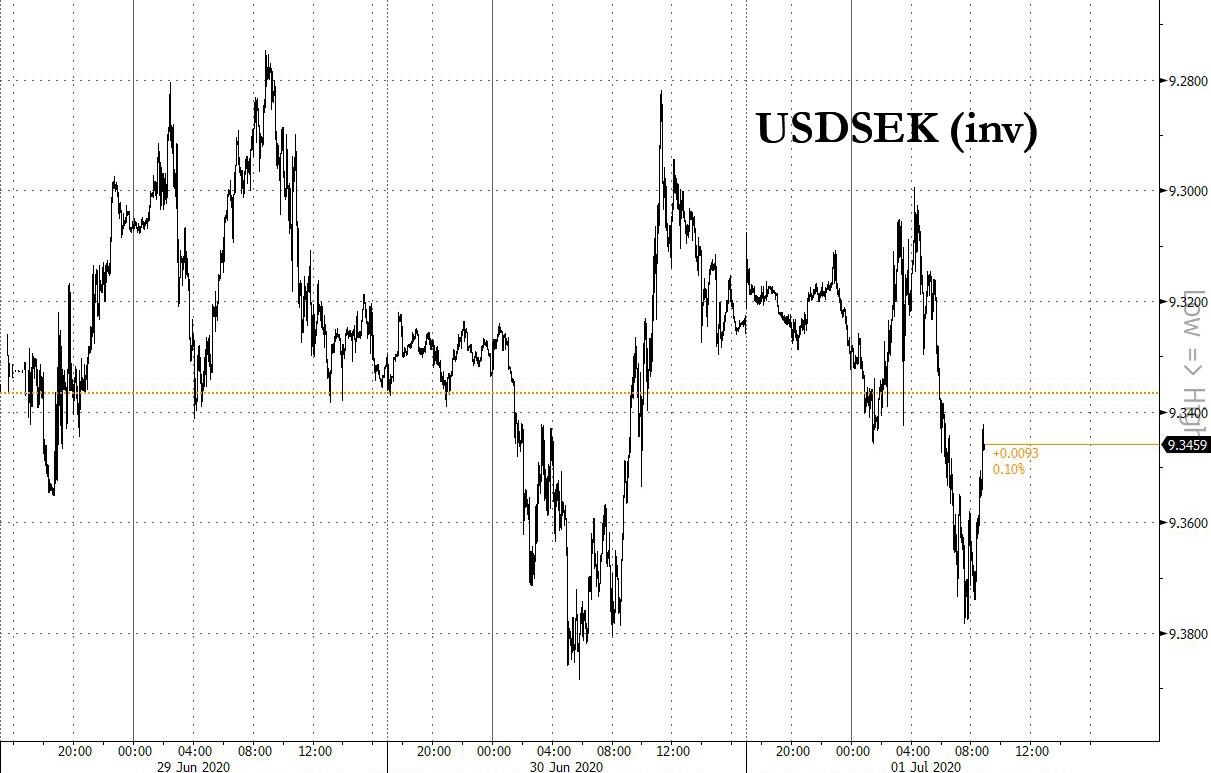Sweden Expands QE By 66%
Tyler Durden
Wed, 07/01/2020 – 09:02
With central banks having officially taken over capital markets, they are finding it impossible to not only walk away but to even slow down the rate of intervention.
This morning, Sweden’s Riksbank announced it would increase the size of its asset purchase program, i.e., QE, from SEK300bn to SEK500bn, and extended the end-point of the purchases to 30 June 2021. The Executive Board also decided to cut interest rates and extend maturities on lending to banks, but kept the repo rate unchanged at 0%. While the median forecast of the repo rate published in the Monetary Policy Report shows it remaining at zero until the end of the forecast horizon, the Riksbank stressed that the “repo rate can […] be cut, if this is assessed to be a useful measure.” The Riksbank also published new economic forecasts, and now expects GDP to contract by 4.5% in 2020, closer to the more benign scenario published in April.
Courtesy of Goldman, here are the key points in the Riksbank’s announcement:
- The Executive Board announced that the Riksbank will increase the size of its asset purchase programme from SEK300bn to SEK500bn, and extended the end-point of the purchases to 30 June 2021. As part of this, the Riksbank will start to purchase corporate bonds up to SEK10bn in September. The Executive Board also decided to cut interest rates on the standing loan facility (by 10bp) and on extraordinary loans (by 20bp), but kept the repo rate unchanged at 0%. The programme under which the Riksbank lends to banks for onward lending to Swedish corporates was also tweaked: the interest supplement that applies if banks do not meet the requirement for onward lending to Swedish firms will be cut by 10bp and the maturity of the loans extended from two to up to four years.
- The Monetary Policy Report (MPR), also published today, shows that the Riksbank expects GDP to contract by 4.5% this year before recovering to 3.6% and 4.1% growth in 2021 and 2022, respectively. CPIF inflation is expected to be 0.4% this year, in large part driven by low energy prices, and then reach 1.8% in 2023Q3, still 0.2pp below the inflation target. Broadly speaking, this forecast is closer to the more benign scenario published in April; nevertheless, the Riksbank forecasts that the repo rate will remain firmly at zero until the end of the forecast horizon.
- Looking ahead, the MPR reiterated that the “repo rate can […] be cut, if this is assessed to be a useful measure.” The Riksbank cites the exchange rate, how fast the supply side of the economy recovers, and the pass-through of the repo rate to interest rates in the broader economy as factors it will consider when assessing the usefulness of an interest rate cut. The MPR also states that the existing liquidity and lending programmes can be extended, should the economic situation warrant it.
- The Riksbank will remain on hold for the foreseeable future; look to the Minutes of the monetary policy meeting published next week Friday (10 July) for any signs of disagreement on a repo rate cut among the members of the Executive Board.
Pointing out the obvious, SEB said the Riksbank continues to use its balance sheet to support growth, deciding to extend the QE program until June 2021 by increasing it to SEK500b, which means that it will continue to purchase assets at approximately the current pace of around SEK30b-35b also during the first half of next year. The bank also said both the QE program and unchanged repo rate until the end of 2023 were in line with its expectations, adding that “on the margin the decision was slightly more dovish than market expectation as most analysts expected the QE program to be on hold for now, although an extension of the program at a later point in time was widely expected.”
That said, looking at the SEK, after dipping initially, the Swedish currency is largely unchanged as a result.
via ZeroHedge News https://ift.tt/2BthgKH Tyler Durden
